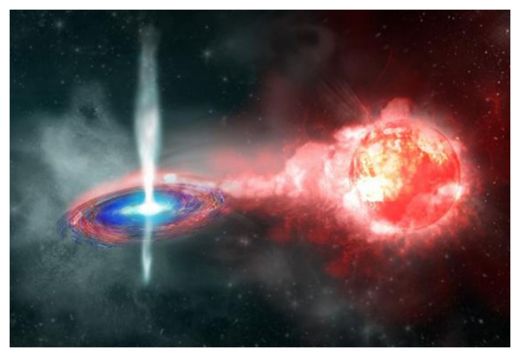
© Kavli IPMU Artist's conception of Type Ia Supernova.
Four years ago a team of scientists observed a supernova -
PS1-10afx - shining brighter than any other in its class. Reporting the observation last year in the
Astrophysics Journal Letters, University of Tokyo researchers said they had discovered the first Type Ia Supernova (SNIa) that exploded more than nine billion years ago.
Now, the same team of researchers, led by
Robert Quimby, of the University of Tokyo's Kavli Institute for the Physics and Mathematics of the Universe, said the exceptionally bright supernova they reported in 2013 is so luminous because a lens in the sky amplified its light. The discovery settles an important controversy in the field of astronomy.
"PS1-10afx is like nothing we have seen before," said Quimby.
Its exceptional glow was very puzzling, leading some to conclude it was a new type of extra-bright supernova, while others suggested it was a normal SNIa magnified by a lens in the form of a massive object, such as a nearby supermassive black hole.
"The team that discovered it," Quimby said, "proposed that it was a new type of supernova, one that no theory predicted."
The PS1-10afx supernova is 30 times brighter than any supernova found before it and the research team now say this SNIa is the first example of strong gravitational lensing of a supernova, confirming the team's previous explanation for the unusual properties of this supernova.
The team's research has further shown that such discoveries of SNIa can be made far more common than previously thought possible.
"SNIa seen through gravitational lenses can be used to make a direct measurement of the universe's expansion rate (the Hubble parameter), so this discovery may have a significant impact on how cosmic expansion is studied in the future," said the researchers.
SNIa are tremendously useful in the understanding of the mysterious components of the Universe such as dark energy and dark matter. SNIa have strikingly similar peak luminosities regardless of where they occur in the Universe. This could prove useful in allowing astronomers to use SNIa as standard candles to measure cosmological distance independent of the Universe's expansion.
Distance measurement with SNIa was key to the discovery of accelerating expansion of the Universe (2011 Nobel Prize in Physics).
Only a few, rare supernovae have been discovered with comparable luminosities to this one, according to Quimby, "but PS1-10afx was different in just about every way. It evolved too fast, its host galaxy is too big, and it was way, way too red."
This has led to a different idea by the team.
"We proposed that [its exceptional glow] could be explained as a gravitationally lensed SNIa, but we had no direct evidence for the lens. Thus each explanation [to date] required a bit of magic - new physics or an unseen magnifier - and scientists don't generally buy into magic."
Their hypothesis, however, came with a testable prediction. If there was a gravitational lens there to magnify the supernova, it would still be there after the supernova faded. With this understanding, the team went back to get new and better data to check for the signature of this gravitational lens.
Quimby and colleagues compared spectroscopic data from PS1-10afx's peak brightness period to data from the period after it faded. The team posited that if there was an additional galaxy coinciding with PS1-10afx, there would be two observable sets of gas emission lines - and that is exactly what they found.
To make the connection, the team inferred the presence of another galaxy sitting right in front of PS1-10afx - one that, at just the right angle and distance from the SNIa, served as a magnifying lens, amplifying the explosion's brightness.
Quimby explained why this lens was missed in the previous work: "It turns out that PS1-10afx's host galaxy appears brighter than the lens galaxy...so the light of the lens was simply lost in the host's glare."
Quimby noted that astronomers have found lots of examples of gravitational lensing, but by most accounts, these have been so-called 'weak' gravitational lenses. The galaxy in front of PS1-10afx is the first to strongly magnify a Type Ia supernova.
But still, in order to create the extra-bright appearance of PS1-10afx, Quimby explained that there had to be multiple images of the supernova that formed.
Multiple images created through lensing offer a means to test cosmic expansion.
"Each image will arrive at a different time with the exact delay dependent on how fast the universe is expanding. In principle, measuring this delay provides a direct way [more so than existing methods] to measure cosmic expansion," said Quimby.
However, the team was unable to do this with PS1-10afx because it faded away before they identified its importance.
"But now we know what to look for," Quimby added. And this may enable scientists to use future lensed supernova events to measure expansion in the universe.
"In the future, when a target is identified as a possible lensed Type Ia supernova, high-resolution follow-up observations can be taken to resolve the individual image components," said Quimby.
Each image comes from the same source but travels a different path length on its way to the observer, so there is an arrival time difference between these multiple supernova images. If this "time delay" can be measured, a direct test of cosmic expansion is possible, faster expansion leads to shorter time delays. By timing the delays precisely and comparing these to the delay expected from the geometry of the lens, expansion history of the Universe can be directly inferred.
"The discovery and selection method we have crafted may thus soon improve our understanding of our expanding universe," Quimby concluded.
Reader Comments
to our Newsletter